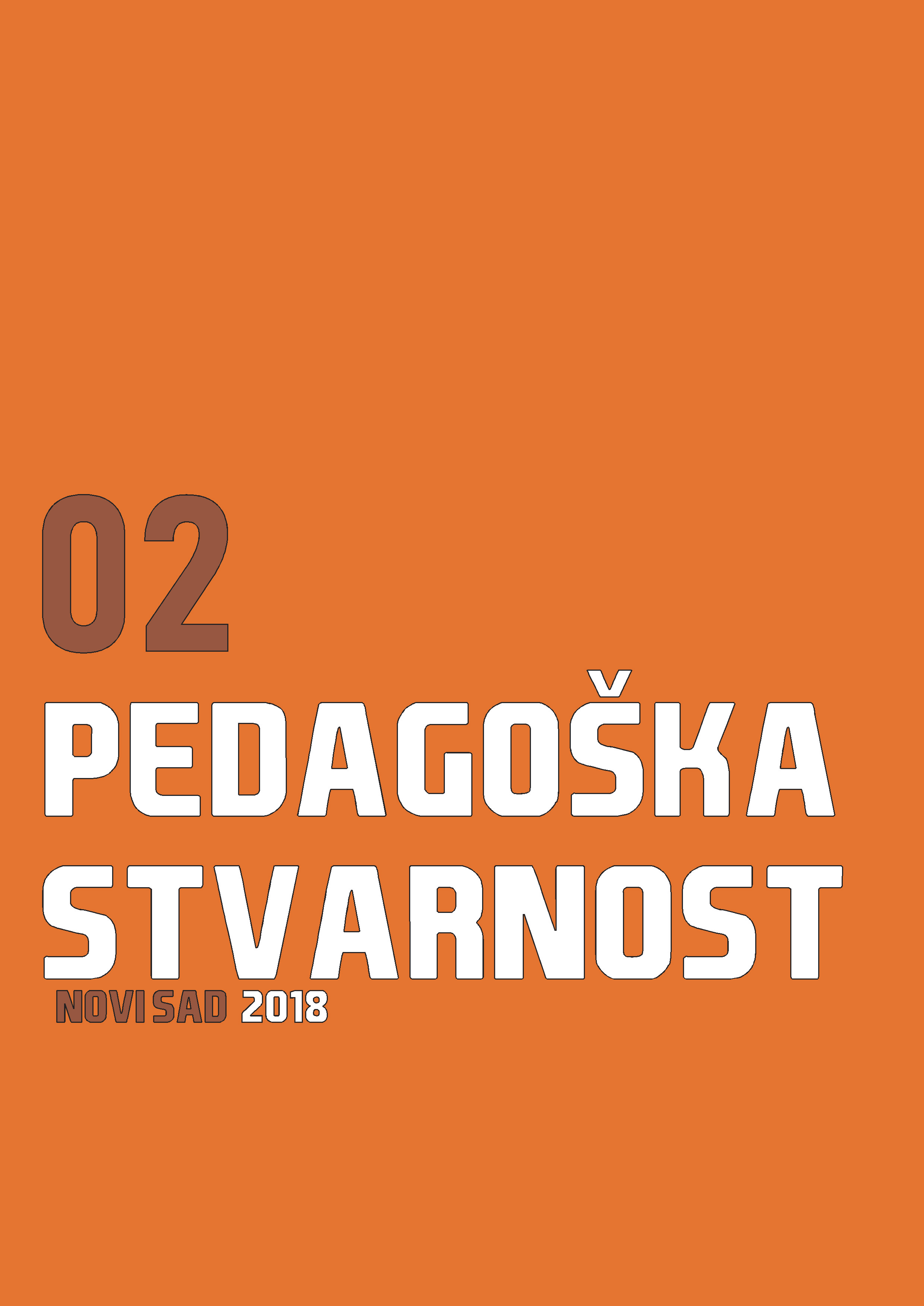RAZVOJNI POREMEĆAJ KOORDINACIJE- IMPLIKACIJE NA ŠKOLSKU PRAKSU
Apstrakt
Razvojni poremećaj koordinacije (RPK) predstavlja neurološki poremećaj, odnosno poremećaj pokreta (procesa ideje, motornog planiranja i izvršenja pokreta). RPK utiče na svakodnevne veštine ali i na školska postignuća. Visoka prevalencija (5-8 %) govori u prilog tome da u svakom razredu ili vrtićkoj grupi možemo očekivati jedno dete/učenika za ovim problemom. Danas, za dijagnostikovanje ovog poremećaja koristimo DSM-V (Diagnostic and Statistical Manual of Mental Disorders, Fifth Edition) klasifikaciju (četiri kriterijuma). Prema ovom statističkom priručniku RPK se dijagnostikuje ako je izvođenje motoričkih veština ispod hronološkog uzrasta, ako ometa svakodnevne aktivnosti, ako je početak u razvojnom periodu i ako se motorički deficit ne može objasniti nekim drugim oštećenjem (npr. cerebralnom paralizom). Etilogija RPK je multifaktorska. Najviše problema učenici sa RPK pokazuju na nastavi fizičkog vaspitanja, srpskog jezika i matematike. Teškoće sa kojima se susreću su mnogobrojne počev od problema pripreme za čas fizičkog vaspitanja, učešća u takmičarskim igrama, preko problema čitanja, pisanja i računanja. U osnovi ovih teškoća leži problem motoričkog učenja. Zbog svega, vrlo je važno koristiti odgovarajuće strategije za rad sa ovim učenicima. Pravovremenim tretmanom, primenom odgovarajućih metoda i strategija u radu može se uticati na dalji tok i ishod ovog razvojnog poremećaja.
Reference
American Psychiatric Association. (2013). DSM-V: Diagnostic and Statistical Manual of Mental Disorders. 5th ed. Washington, DC: American Psychiatric Association.
Appleton, J., Appleton, R., & Gibbs, J. (2007). Dyspraxia or developmental coordination disorder: unravelling the enigma. Archives of Disease in Childhood, 92, 534-9.
Bailey, R. (2003). Teaching physical education: A handbook for primary and secondary school Teachers. London: Kogan Page Limited.
Ball, M. (2002). Developmental coordination disorder: Hints and tips for the activities of daily living. London: Jessica Kingsley Publishers.
Barnett, A., Plumb, M., Prunty, M., & Wilmut, K. (2014). An examination of writing pauses in the handwriting of children with Developmental Coordination Disorder. Research in Developmental Disabilities, 35, 2894-2905.
Barnhart R. C., Davenport M. J., Epps S. B., & Nordquist V. M. (2003). Developmental coordination disorder. Physical Therapy, 83(8), 722-31.
Blank, R., Mosterd-Van Der Meijs, R., Polatajko, H., Smits-Engelsman, B., Van Der Kaay, A., Vlugt-Van Den Brand, E., & Wilson, P. (2013). Efficacy of interventions to improve motor performance in children with developmental coordination disorder: a combined systematic review and meta-analysis. Developmental Medicine & Child Neurology, 55, 229-237.
Cairney, J., Faught, B. E., Flouris, A., Hay, J., Mandigo, J., & Wade, T. (2007). Developmental coordination disorder and reported enjoyment of physical education in children. European Physical Education Review, 13 (1), 81-98.
Cairney, J., Faught, B. E., Hay, J., Missiuna, C., Spironello, C. A., & Veldhuizen, S. (2008). Screening for motor coordination challenges in children using teacher ratings of physical ability and activity. Human Movement Science, 27, 177-189.
Cermak, S. A., Gubbay, S. S., & Larkin, D. What is developmental coordination disorder? In Cermak, S. A., & Larkin, D. (Eds), Developmental coordination disorder (pp. 2-22). Albany, Delmar Thompson Learning.
Crawford, S. G., Dewey, D., Kaplan, B. J., & Wilson, B. N. (2002). Developmental coordination disorder: associated problems in attention, learning, and psychosocial adjustment. Human Movement Science, 21, 905-918.
Chen, J-Y., Cheng, H-C., Cherng, R-J., Shen, M-L., Tsai, C-L. (2011). Reading and writing performances of children 7-8 years of age with developmental coordination disorder in Taiwan. Research in Developmental Disabilities, 12, 2589-2594.
Dehaene, S., Dehaene-Lambertz, G., Gomez, A., Huron, C., Jobert, A., & Piaza, M. (2015). Mathematical difficulties in developmental coordination disorder: Symbolic and nonsymbolic number processing. Research in Developmental Disabilities, 43-44, 167- 168.
Desoete, A., Pieters, S., Roeyers, H. Van Waelvelde, H., & Vanderswalmen, R. (2012). Mathematical problems in children with developmental coordination disorder. Research in Developmental Disabilities, 33, 1128-1135.
Đorđić, V. (2010). Nespretno dete u nastavi fizičkog vaspitanja. Nastava i vaspitanje, 3, 425-36.
Emond, A., Golding, J., Hunt, L., Jongmans, M., & Lingam, R. (2009). Prevalence of Developmental Coordination Disorder Using The DSM-IV at 7 Years of Age: A UK Population Based Study. Pediatrics, 123 (4), 693-700.
Emond, A., Harrowell, I., Hollen, L., & Lingham, R. (2018). The impact of developmental coordination disorder on educational achievement in secondary school. Research in Developmental Disabilities, 72, 13-22.
Ellinoudis, T., Gitsas, K., Kiparissis, M., & Kourtessis, T. (2009). Ability to detect movement difficulties in children aged 7-12 years by physical education teachers using the assessment package Movement Assessment Battery for Children. Physical Education & Sports, 29(3), 288-306.
Ellinoudis, T., Kioumourtzoglou, E., Kiparissis, M., Kourtessis, T., Maheridou, M., Tsigilis, N. (2008). The influence of a short intervention program on early childhood and physical education teacher ability to identify children with developmental coordination disorders. Journal of Early Childhood Teacher Education, 2(4), 276-286.
Gaines, R., Missiuna, C., & Soucie, H. (2006). Why every office needs a tennis ball: a new approach to assessing the clumsy child. Canadian Medical Association Journal, 175(5), 471-473.
Geuze, R. H. (2005). Postural control i children with developmetnal coordination disorder. Neural Plasticity, 12, 183-96.
Geuze, R. H., Jongmans, M. J., Schoemaker, M. M., & Smits-Engelsman. (2001). Clinical and research diagnostic criteria for developmental coordination disorder: a review and discussion. Human Movement Science, 20, 7-47.
Gillberg, C. (2003). Deficits in attention, motor control, and perception: a brief review. Archives of Disease in Childhood, 88, 904-10.
Hay, D. A., Levy, F., Martin, N. C., Pearsall-Jones, J. G., Piek, J. P., & Rigoli, D. (2008). A monozygotic twin design to investigate etiological factors for DCD and ADHD. Journal of Pediatric Neurology, 6(3), 209-19.
Henderson, S. E., & Sugden, D. A. (1992). Movement assessment battery for children. London: Psychological Corporation.
Hillier, S. (2007). Intervention for children with developmental coordination disorder: a systematic review. The Internet Journal of Allied Health Sciences and Practice. Retrived October 2018 from http://ijahsp.nova.edu
Krstić, N. (2008). Razvojna neuropsihologija. Beograd: Fakultet za specijalnu edukaciju i rehabilitaciju.
Lange, S. (2018). ADHD and Comorbid developmental Coordinationd Disorder: Implications and Recommendations for School Psychologists. Contemporary School Psychology, 22, 30-39.
Lavay B. W. (2005). Specific learning disabilities, In J. P. Winnick (Ed.), Adapted physical education and sport (pp. 189-204). Champaign, IL: Human Kinetics.
Leeds Consensus Statement: Developmental coordination disorder as a specific learning difficulty. (2006). Leeds: Economic and Social Research Council.
Livneh-Zirinski, M., & Rosenblum, S. (2008). Handwriting process and product characteristics of children diagnosed with developmental coordination disorder. Human Movement Science, 27(2), 200-214.
Magalhăes, L. C., Missiuna, C., & Wong, S. (2006). Terminology used in research reports of developmental coordination disorder. Developmental Medical & Child Neurology, 48. 937-941.
McKanzie, B. E., & Wilson, P. H. (1998). Information processing deficits associated with developmental coordination disorder: A meta-analysis of research findings. Journal of Child Psychology and Psychiatry, and Allied Disciplines, 39, 829-840.
McLean, J., Missiuna, C., Gaines, R., & Soucie, H. (2006). Parental questions about developmental coordination disorder: A synopsis of current evidence. Paediatrics and Child Health, 11(8), 507-512.
Missiuna, C. (2003). Children with developmental coordination disorder: at home and in the Classroom. Hamilton, ON: CanChild, Centre for Childhood Disability Research.
Missiuna, C, Gaines, R, Soucie, H, McLean, J. (2006): Parental questions about developmental coordination disorder: A synopsis of current evidence. Paediatrics and Child Health, 11(8), 507-512.
Missiuna, C., Pollock, N., & Rivard, L. (2004). They're bright but can't write: Developmental coordination disorder in school aged children. Canadian Journal of Occupational Therapy, 73, 7-17.
Pavlović, D. (2011). Neuropsihologija sa osnovama bihevioralne neurologije. Beograd: Kaligraf.
Piek, J. P., & Skinner, R. A. (2001). Psychosocial implications of poor motor coordination in children and adolescents. Human Movement Science, 20(1-2), 73-94.
Portwood M. (1999). Developmental Dyspraxia; Indetification and Intervention; A Manual for parents and Professionals. 2nd Edition. London: David Fulton Publishers.
Sugden D., & Wade, M. (2013). Typical and Atipical Motor Development. London: Mac Keith Press.
Sutton-Hamilton S. (2002). Evaluation of clumsiness in children. American Family Physician, 66(8), 1435-40.







